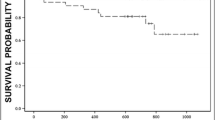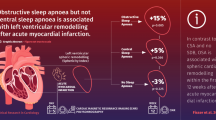Abstract
Objectives
The aims of our study were 1) to better characterize central periodic breathing during sleep (CPBS) and its clinical relevance in acute stroke, 2) to better define the role of brain damage in its pathogenesis.
Methods
We included 74 consecutive patients admitted within 96 hours after stroke onset. Stroke severity at admission, stroke outcome at discharge and stroke topography were assessed. ECG and transesophageal echocardiography were performed. Nocturnal breathing was assessed with an ambulatory device the first night after admission. CPBS severity was represented as absolute time and percentage of recording time.
Results
Age was 63 ± 13 (25–82), 49 (66 %) were male. Thirty (41 %) patients showed CPBS during ≥ 10 % and 7 (9 %) during ≥ 50 % of recording time. CPBS severity was associated with age (p = 0.017), stroke severity (p = 0.008), ECG abnormalities (p = 0.005) and lower left ventricular ejection fraction (p < 0.0001). CPBS severity was higher in patients with extensive hemispheric strokes (n = 6, p < 0.0001), and lower in patients with partial strokes involving the left insula (n = 5, p < 0.0001) and the mesencephalon (n = 5, p = 0.002).
Conclusions
CPBS is frequent in acute ischemic stroke and is associated with older age, stroke severity/extension, and lower left ventricular function. The lower occurrence of CPBS in left insular and mesencephalic stroke suggests a major role of distinct brain areas in the modulation of respiratory phenomena accompanying acute stroke.
Similar content being viewed by others
References
No authors listet (1999) Sleep-related breathing disorders in adults: recommendations for syndrome definition and measurement techniques in clinical research. The Report of an American Academy of Sleep Medicine Task Force. Sleep 22:667–689
Plum F, Swanson AG (1959) Central neurogenic hyperventilation in man. AMA Arch Neurol Psychiatry 81:535–549
Lee MC, Klassen AC, Resch JA (1974) Respiratory pattern disturbances in ischemic cerebral vascular disease. Stroke 5:612–616
Bassetti C, Aldrich MS, Quint D (1997) Sleep-disordered breathing in patients with acute supra- and infratentorial strokes. A prospective study of 39 patients. Stroke 28:1765–1772
Bassetti C, Aldrich MS (1999) Sleep apnea in acute cerebrovascular diseases: final report on 128 patients. Sleep 22:217–223
Parra O, Arboix A, Bechich S, et al. (2000) Time course of sleep-related breathing disorders in first-ever stroke or transient ischemic attack. Am J Respir Crit Care Med 161:375–380
Iranzo A, Santamaria J, Berenguer J, Sanchez M, Chamorro A (2002) Prevalence and clinical importance of sleep apnea in the first night after cerebral infarction. Neurology 58:911–916
Bassetti C, Aldrich MS, Chervin RD, Quint D (1996) Sleep apnea in patients with transient ischemic attack and stroke: a prospective study of 59 patients. Neurology 47:1167–1173
Bassetti CL, Milanova M, Gugger M (2006) Sleep disordered breathing and acute stroke: diagnosis, risk factors, treatment, evolution and outcome. Stroke 37:967–972
Hermann DM, Siccoli M, Kirov P, Gugger M, Bassetti CL (2007) Central periodic breathing during sleep in acute ischemic stroke. Stroke 38:1082–1084
Rowat AM, Wardlaw JM, Dennis MS (2007) Abnormal breathing patterns in stroke: relationship with location of acute stroke lesion and prior cerebrovascular disease. J Neurol Neurosurg Psychiatry 78:277–279
Rowat AM, Dennis MS, Wardlaw JM (2006) Central periodic breathing observed on hospital admission is associated with an adverse prognosis in conscious acute stroke patients. Cerebrovasc Dis 21:340–347
Solin P, Roebuck T, Johns DP, Walters EH, Naughton MT (2000) Peripheral and central ventilatory responses in central sleep apnea with and without congestive heart failure. Am J Respir Crit Care Med 162:2194–2200
Javaheri S (1999) A mechanism of central sleep apnea in patients with heart failure. N Engl J Med 341:949–954
Sin DD, Fitzgerald F, Parker JD, Newton G, Floras JS, Bradley TD (1999) Risk factors for central and obstructive sleep apnea in 450 men and women with congestive heart failure. Am J Respir Crit Care Med 160:1101–1106
Nopmaneejumruslers C, Kaneko Y, Hajek V, Zivanovic V, Bradley TD (2005) Cheyne-Stokes Respiration in Stroke: Relationship to Hypocapnia and Occult Cardiac Dysfunction. Am J Respir Crit Care Med 171:1048–1052
Nachtmann A, Siebler M, Rose G, Sitzer M, Steinmetz H (1995) Cheyne-Stokes respiration in ischemic stroke. Neurology 45:820–8821
Brott T, Adams HP Jr, Olinger CP, et al. (1989) Measurements of acute cerebral infarction: a clinical examination scale. Stroke 20:864–870
Rankin J (1957) Cerebral vascular accidents in patients over the age of 60. II. Prognosis. Scott Med J 2:200–215
Bamford J, Sandercock P, Dennis M, Burn J, Warlow C (1991) Classification and natural history of clinically identifiable subtypes of cerebral infarction. Lancet 337:1521–1526
Tatu L, Moulin T, Bogousslavsky J, Duvernoy H (1998) Arterial territories of the human brain: cerebral hemispheres. Neurology 50:1699–1708
Meoli AL, Casey KR, Clark RW, et al. (2001) Hypopnea in sleep-disordered breathing in adults. Sleep 24:469–470
Kushida CA, Littner MR, Morgenthaler T, et al. (2005) Practice parameters for the indications for polysomnography and related procedures: an update for 2005. Sleep 28:499–521
Turkington PM, Bamford J, Wanklyn P, Elliott MW (2002) Prevalence and predictors of upper airway obstruction in the first 24 hours after acute stroke. Stroke 33:2037–2042
Rothwell PM, Coull AJ, Giles MF, et al. (2004) Change in stroke incidence, mortality, case-fatality, severity, and risk factors in Oxfordshire, UK from 1981 to 2004 (Oxford Vascular Study). Lancet 363:1925–1933
Schulz UG, Rothwell PM (2003) Differences in vascular risk factors between etiological subtypes of ischemic stroke: importance of populationbased studies. Stroke 34:2050–2059
Benarroch EE (1993) The central autonomic network: functional organization, dysfunction, and perspective. Mayo Clin Proc 68:988–1001
King AB, Menon RS, Hachinski V, Cechetto DF (1999) Human forebrain activation by visceral stimuli. J Comp Neurol 413:572–582
Oppenheimer SM, Kedem G, Martin WM (1996) Left-insular cortex lesions perturb cardiac autonomic tone in humans. Clin Auton Res 6:131–140
Christensen H, Boysen G, Christensen AF, Johannesen HH (2005) Insular lesions, ECG abnormalities, and outcome in acute stroke. J Neurol Neurosurg Psychiatry 76:269–271
Oppenheimer S (2006) Cerebrogenic cardiac arrhythmias: cortical lateralization and clinical significance. Clin Auton Res 16:6–11
Laowattana S, Zeger SL, Lima JA, Goodman SN, Wittstein IS, Oppenheimer SM (2006) Left insular stroke is associated with adverse cardiac outcome. Neurology 66:477–483
Ay H, Koroshetz WJ, Benner T, et al. (2006) Neuroanatomic correlates of stroke-related myocardial injury. Neurology 66:1325–1329
Henderson LA, Macey KE, Macey PM, Woo MA, Yan-Go FL, Harper RM (2006) Regional brain response patterns to Cheyne-Stokes breathing. Respir Physiol Neurobiol 150:87–93
Aleksandrov VG, Aleksandrova NP, Bagaev VA (2000) Identification of a respiratory related area in the rat insular cortex. Canadian journal of physiology and pharmacology 78:582–586
Author information
Authors and Affiliations
Corresponding author
Rights and permissions
About this article
Cite this article
Siccoli, M.M., Valko, P.O., Hermann, D.M. et al. Central periodic breathing during sleep in 74 patients with acute ischemic stroke – Neurogenic and cardiogenic factors. J Neurol 255, 1687–1692 (2008). https://doi.org/10.1007/s00415-008-0981-9
Received:
Revised:
Accepted:
Published:
Issue Date:
DOI: https://doi.org/10.1007/s00415-008-0981-9




